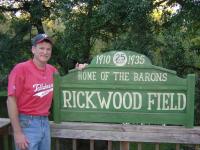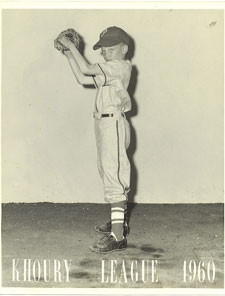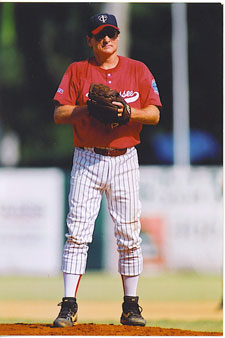

 |
 |
| Books | Reviews | Biography | Articles | Quizzes |
Meet the Author: Rick Swaine |
||
|
"Baseball! I don't want to play baseball! I don't even know how!" whined shy, skinny, eight-year-old Ricky Swaine. Thus my lifetime love affair with the great American National Pastime began in the spring of 1959. 
Encouraged by my parents to participate in a south Florida version of Little League known as Khoury League, I endured a hitless rookie season as the second-string right fielder for the Perrine Civitans. But the seed had been planted and it began flourishing almost immediately. By the end of my first season, I was a vociferous reader of anything baseball (my first voluntarily read novel was The Kid From Tompkinsville by John R. Tunis), began a baseball card collection, rooted the Chicago White Sox to the American League pennant, and was determined to become a decent player. The next season I made the league all-star team as a pitcher and was able to reel off the starting lineup of each major league team and their stats. My budding baseball career became a family project to the lasting disgust of my sister. After originally forcing me to try the game, my parents never pushed me again. They also never missed a game and never failed to lend their support. My father, a disabled veteran, had been an excellent high school and prep school athlete before entering the military service during World War II. Despite being bound to a wheelchair he worked endlessly with me on developing my skills, even coaching my team to the championship one year. He died when I was 14 and my first book, Beating the Breaks, is dedicated to his memory. My mother often caught for me until I developed too much velocity on my fastball and visiting grandfathers and uncles were often drafted for catching duty. Baseball remained my primary interest through high school. I became a good-field-no-hit infielder for Miami-Palmetto Sr. High. Along the way I played other sports with some success, but they all took a backseat to baseball. Unfortunately my baseball career came to a halt at Florida State University when it became evident that I wasn't a good enough player to crack the lineup - nor was I a good enough student to devote so much time to warming the bench. 
Settling in Tallahassee after earning a degree in accounting from FSU, I found athletic outlets in tennis and slow pitch softball, but I still missed playing baseball. At the age of 47, I was still playing a pretty fair game of softball when a friend talked me into joining his team in the city's recently organized Adult Baseball Recreation League. I was the oldest player on the team and still remember when another new recruit and I banged out back-to-back singles for our first hits. After the inning my new 25-year-old teammate remarked that it was his first baseball hit in seven years. He seemed stunned when I told him that my last one had come before he was born. My second career in baseball has been one of the most satisfying experiences of my life. I still manage and play in a local senior baseball league. I also play in various old-timer tournaments throughout the southeast, including the national Roy Hobbs adult baseball tournament in Ft. Myers, Florida every November. In real life, I'd become a Certified Public Accountant (CPA) after graduation and enjoyed a moderately successful career as a financial manager for the State of Florida. I rose to the level of chief financial officer for a couple of major state agencies before recently retiring from public service. I've always been a loyal fan of the game and an avid student of baseball history, but in the 1980s my interest (and investment) rose to a new level when I became aware of the explosion in the popularity of vintage baseball cards. Unlike most of the adult male population of this country, my mother didn't throw my baseball card collection away when I went away to college. In fact she kept them safely stored in the attic. I can't describe the thrill of looking at my 1959 Topps Mickey Mantle for the first time in 20 years. I was hooked again! Using my doubles as a stake, I became a baseball card collector again and now have a collection which includes complete Topps sets for the years 1957 through 1962, 1948 and 1952 Bowman sets, and an extensive collection of vintage cards. During the 1990s I began making some forays into the world of non-fiction baseball writing, although it took me years to work up the courage to let anyone else read my work. I became a member of the Society for American Baseball Research (SABR) and submitted articles that were accepted for publication in the The Baseball Research Journal and The National Pastime. My first full-length manuscript led to a proposal from McFarland for a book about baseball players with disabilities. Most fans are unaware of the number of such players who played in the big leagues. I certainly wasn't before I began work on Beating the Breaks. In fact it was only after considerable research on the subject that I became convinced there was enough for a book. My second book, The Black Stars Who Made Baseball Whole deals with the forgotten generation of early Black major league players whose careers were split between the Negro Leaguers and organized baseball. My third book, The Integration of Major League Baseball: A Team by Team History is a follow up to The Black Stars Who Made Baseball Whole. It focuses on the roles various executives and managers played in improving their teams by extending opportunities to black players or damaged their franchises by refusing to embrace integration of the game. I hope you'll enjoy visiting this web site and learning more about my books. I'd be happy to hear from you and can be reached at swaine@embarqmail.com. Please send your message under a subject title that begins with the word baseball to avoid spam filters. |
||
| ©2004-2022 Rick Swaine - All Rights Reserved |
Contact | Home |